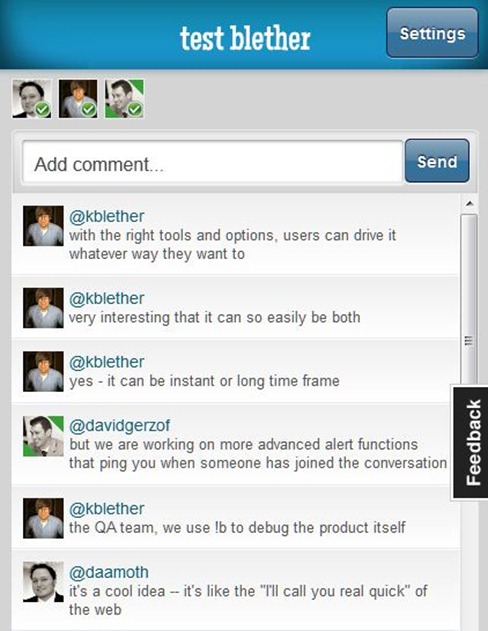If you’ve ever engaged in a bit of back-and-forth with another Twitter user and you realized you needed to take the conversation off of everyone else’s timeline, you may have had to resort to multiple direct messages, e-mail, Skype, or any number of alternative communication methods. Even the dreaded “telephone” you’ve seen in the movies.
New startup “Blether” (it’s technically written “!blether”) provides a dead-simple way to quickly initiate a private chat room with other Twitter users. You begin a tweet with “!b”, add whomever you want to chat with (you can add multiple people), and your message. Basically, your tweet would look something like: !b @person-one @person-two Hey, do you guys have a quick second to chat?
(MORE: Two Bickering Chatbots Video: Artificial Intelligence Gone Awry)
Moments later, everyone who’s involved with the chat will get a Twitter mention from the “Bella Blether” account with a link to a freshly-built private chatroom. Wait for everyone to pop inside and—boom—you’re chatting.
I had some initial trouble with the chat stream not auto-updating in the Google Chrome web browser, a glitch Blether CEO and founder Kevin Bradshaw attributed to “an issue with a certain extension in Chrome” that “maybe one in 500 people are seeing,” but once I switched over to Firefox, everything worked as advertised. I’ll be sending the team a list of my Chrome extensions to see if they can pinpoint which one is causing trouble.

The interface itself is clean and simple, and it works without the need for a special app, so smartphone users can hop right into a chat with desktop users without missing any of the action.
And with that, let’s move on to five questions with Blether CEO and founder Kevin Bradshaw.
article continues on next page…
Q: How long did it take to build?
“We’ve been working on the underlying platform for about a year (http://zendit.com). It has a lot of capability beyond what you see today in !blether. !blether itself was a couple of months from conception to live beta in its current form.”
Q: How many people on the team?
“We have 10 full-time engineers and QA people in the team (in Scotland).”
Q: What’s going on behind the curtain when a connection is established?
“The short version is that a conversation host session is created on our servers and set up to only accept logins from specified Twitter identities. They are invited, are sent a link and click it to login.
The rest is solid real-time web tech and some smart UI work (especially for small screens). That’s a huge plus—no app—meaning we run pretty much immediately on any web enabled device right now.”
Q: What was the biggest challenge as far as getting everything working correctly?
“Twitter integration was not too tricky; their API is solid and well documented. The platform itself has a lot of functionality that took a while to get right—there are a lot of interconnections between devices, servers and different external services that are needed to do this well and make it scalable.
The UI took a little while to get right—check out how it automatically redraws itself if you narrow the web browser window you are in! That’s how we support so many devices already; the web UI does a lot of smart things.”
Q: What sorts of features do you have planned for future iterations?
“All sorts. Users are already asking for a lot of things – first up will likely be archiving, exporting chats, etc. Then probably photo sharing, which we already have tested, just don’t want to complicate the product too much too quickly.
Beyond this, the ability to turn a chat public, or to allow a controlled number of users to join (without being explicitly invited) is a major direction for us. Then you’d be able to post links to chats onto other networks, or email them, that sort of thing.
We’ve already had interest from a couple of pretty large corporates too—I think the way we’ve built this, it’s just hit a nerve and practically anyone on the internet is going to be able to get value from it. There is every reason to believe it will be as useful in business as for personal use. I’ve actually done five interviews just this week on it myself!
So—a prosumer version with extended features (that isn’t free) and potentially enterprise solutions, I think both are very likely.
We think !blether, given the way it is architected and the utter simplicity of using it, is going to open up all sorts of new scenarios. We’re looking forward to this.”
The current service is free and in beta right now. Hop on over to Blether’s website to check it out, or simply craft a tweet starting with “!b” (no quotes) and include one or more additional Twitter users on it.
MORE: Facebook Boston? Zuckerberg Recruits Harvard, MIT Students

